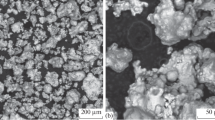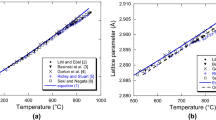Conclusions
Coercive force measurements were made on grades PZh4M3, PZhCh3SV, PZhCh3MV, NC 100.24, PZhR(0) and PZhÉ iron powders and magnetic cores heat treated in the temperature range 750–1200°C. Iron powders of large specific surface are characterized by greater coercive forces compared with powders of small specific surface. Grades PZhCh3SV, PZhCh3MV, NC 100.24, and PZhR(0) iron powders are suitable for the manufacture of magnetic cores after they have been alloyed with elements decreasing internal stresses in alloys. Sintered magnetic cores from PZhÉ electrolytic iron powder meet all the requirements of TU 16-538.225-74 without alloying. The properties of grades EMP300M, PM282N, KiP 270.MS, and SC 100.26 iron powders were assessed. KiP 270.MS and SC 100.26 powders possess the same properties as PZhCh3SV, PZhCh3MV, and NC 100.24 powders, but in grade SC 100.26 powder high oxygen contents are not permissible. Consequently, magnetic cores made from this powder will exhibit high coercivity. Grades EMP300M and PZhR(0) iron powders are similar in all their properties, and the magnetic characteristics of cores made from them will therefore also be comparable. Grade PM282N iron powder is produced by the electrolysis of solutions and characterized by a dendritic particle shape. Owing to the large specific surface of the particles of this powder, its coercive force will be 25–30 A/m greater than that of PZhÉ. In the manufacture of magnetic cores from this powder recourse must therefore be had to alloying with silicon in order to decrease their coercivity.
Similar content being viewed by others
Literature cited
Ya. Morioka, “Investigation and development of a method of manufacture of reduced iron powders suitable for the production of high-density parts,” Funtai Oyobi Funmatsuyakin,22, No. 8, 247–256 (1976).
A. B. Suchkov, T. N. Ermakova, Z. A. Tubyshkina, A. A. Sozina, and B. F. Kovaleva, Inventor's Certificate No. 323463; Byull. Izobret., No. 1 (1972).
T. N. Ermakova, Z. A. Tubyshkina, A. B. Suchkov, et al., “Production and properties of an electrolytic iron powder,” in: Direct Production of Iron in Powder Metallurgy [in Russian], Vol. 7, Moscow (1974), pp. 134–137.
F. Vicena, “Effect of dislocations on the coercive force of ferromagnetics,” Czech. Phys. J.,6, No. 4, 480–499 (1955).
E. M. Kondorskii, “On the theory of coercive force,” Dokl. Akad. Nauk SSSR,63, No. 5, 507–510 (1948).
B. V. Molotilov and I. N. Golikov, “Effect of nonmetallic inclusions on the structure of magnetic alloys,” Metalloved. Term. Obrab. Met., No. 8, 46–51 (1961).
D. D. Mishin, V. F. Novikov, and V. M. Kalinin, “Magnetic, mechanical, thermal, and optical properties of solids,” Uch. Zap. Ural'sk. Univ. im. Gor'kogo, Ser. Fiz., No. 1, 15–19 (1965).
S. V. Vonsovskii, Magnetism. Magnetic Properties of Diapara-, Ferri-, Antiferro-, and Ferromagnetics [in Russian], Nauka, Moscow (1971).
A. S. Petrov and A. V. Trifonova, “Coercive force as the basis of a method for controlling the quality and properties of iron powders,” Elektron. Tekh., Ser. Mater., No. 4, 104–108 (1980).
V. I. Chichernikov, Magnetic Measurements [in Russian], Moscow State University, Moscow (1969).
A. S. Petrov, S. A. Loginov, L. P. Kolokol'tseva, and Z. S. Egorova, “Vacuum heat treatment of magnetic materials from grade PZhO iron powders,” Elektrotekh. Prom., Ser. Elektr. Mater., No. 12, 12–15 (1975).
Author information
Authors and Affiliations
Additional information
Translated from Poroshkovaya Metallurgiya, No. 6(234), pp. 73–78, June, 1982.
Rights and permissions
About this article
Cite this article
Petrov, A.S., Suchkov, A.B., Ermakova, T.N. et al. Manufacture of magnetic cores from various iron powders. Powder Metall Met Ceram 21, 485–489 (1982). https://doi.org/10.1007/BF00801762
Revised:
Issue Date:
DOI: https://doi.org/10.1007/BF00801762




